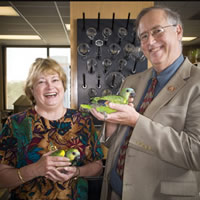Birdman Worries Too About BP’s Air Emissions
Jeff Gaffney, chair of UALR’s Department of Chemistry and his wife and co-researcher, Nancy Marley, share their home with 10 exotic and colorful birds — an umbrella cockatoo named Angel, a pair of African grey  parrots Tasha and Ninah, blue and gold macaws Keebler and Bozo, and a family of blue front Amazon parrots Maxwell and Roxanne and their week-old chick. And he has a European starling named Beetlejuice and a breeding pair of zebra finches.
parrots Tasha and Ninah, blue and gold macaws Keebler and Bozo, and a family of blue front Amazon parrots Maxwell and Roxanne and their week-old chick. And he has a European starling named Beetlejuice and a breeding pair of zebra finches.
So it is no wonder Gaffney’s heart goes out to the thousands of sea birds caught in the thick goo of BP’s underwater gusher fouling the Gulf of Mexico shoreline from Florida to Texas.
And his concern over the ecological impact of the underwater oil gusher goes beyond birds and sea animals. Not only is crude oil gushing out of the broken BP drilling head, so is untold amounts of fossil organics that are also going into the atmosphere, and some that will end up being degraded deep in the Gulf by bacteria to generate methane.
“Methane — natural gas — is greenhouse gas and also has a long life time — from six to 10 years,” Gaffney said. “So it can impact the stratosphere and actually is a source of water vapor there. This actually can lead to enhance stratospheric ozone loss — ozone in the higher atmosphere that shields us from harmful UV radiation.”
Other natural gas emissions are two-, three-, four-, and five-carbon hydrocarbons that are more reactive and interact with nitrogen oxides in the troposphere – lower atmosphere where humans live. The hydrocarbons enhance the formation of tropospheric ozone.
“That is also a greenhouse gas. It is also toxic to plants and is not good for us to breathe — hence the ozone warning days here in Little Rock,” the chemist said.
He and his wife’s research group conducts ongoing research in atmospheric and environmental chemistry. The Gaffney/Marley Research Group currently is focused on the role that atmospheric aerosols play in climate — particularly the role of carbonaceous aerosols and black carbon or soots. Gaffney has been the lead scientist for the Department of Energy’s Atmospheric Science Program’s Megacity Aerosol Experiment – Mexico City (MAX-Mex).
“In the wake of the BP blowout, Dr. Marley and I are wondering if we will see any of the oil get lofted as aerosols if we have a hurricane come into the gulf and then have storms bring that material into our area,” Gaffney said.
He and Marley have established an atmospheric observatory on the rooftop of UALR’s Science Lab building and are taking aerosol and precipitation samples. They also are involved in a month-long Department of Energy field study on climate in northern California through June 28. The study — Carbonaceous Aerosols and Radiative Effects Study, or CARES — is designed to increase the scientific knowledge about evolution of black carbon and secondary organic aerosols from man-made and biogenic sources.
“Currently I have my students analyzing these samples and a hail sample, and we’re also collecting more aerosol samples in the CARES study in Cool, Calif. I go back later this month to pick up the equipment and haul it back to UALR.”
Gaffney, chair of the American Chemical Society’s subcommittee on policy within the Committee on Chemistry and Policy, has been urging Congress to move forward with a proposed energy bill.
“I am hoping that the Senate moves forward to put in place a sustainable energy plan,” he said. “We’re currently writing energy statements for ACS to go to the hill.”
But a bill in Congress won’t help the birds struggling in the Gulf. Gaffney explains the process of cleaning birds and other wildlife: using lighter, natural oils to remove the heavy crude from delicate feathers birds and webbed parts of sea turtles.
“What you’re trying to do is use materials that we know are natural, that will be least potential materials that won’t cause more of a problem to them,” Gaffney said, commenting on the grocery store items like mayonnaise, canola oil, and gentle dish soap being used to clean sea life caught in the BP sludge.
“If you had gum in your hair, what do you do? You brush it; you use this stuff. You’d put some oil in there, mix it, and try to get it off.”
Despite valiant efforts to rescue the birds from the muck, Gaffney said survival is not near assured.
“The ones they’re cleaning up will probably have a 50 to 80 percent chance of survival. But then what do you do with the birds? Most animals will attempt to adjust, but the reality is these are really stressed birds and animals,” he said. “How well they’re going to handle this stuff, I don’t know.”